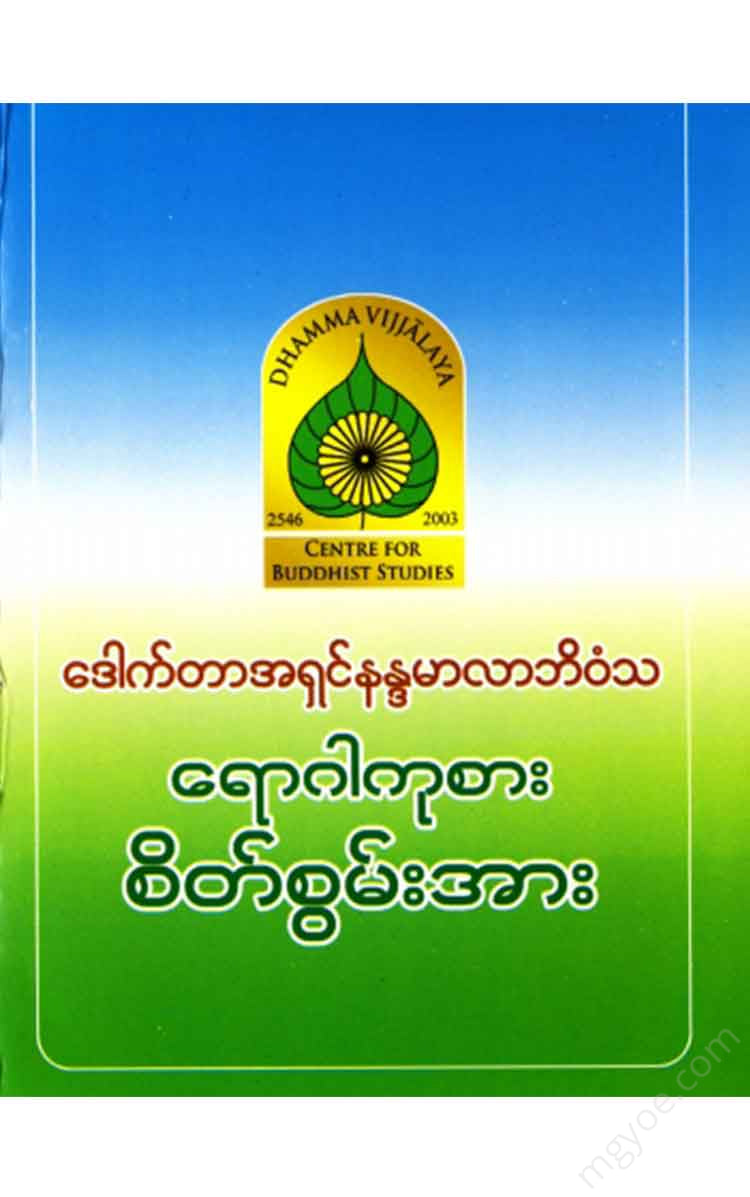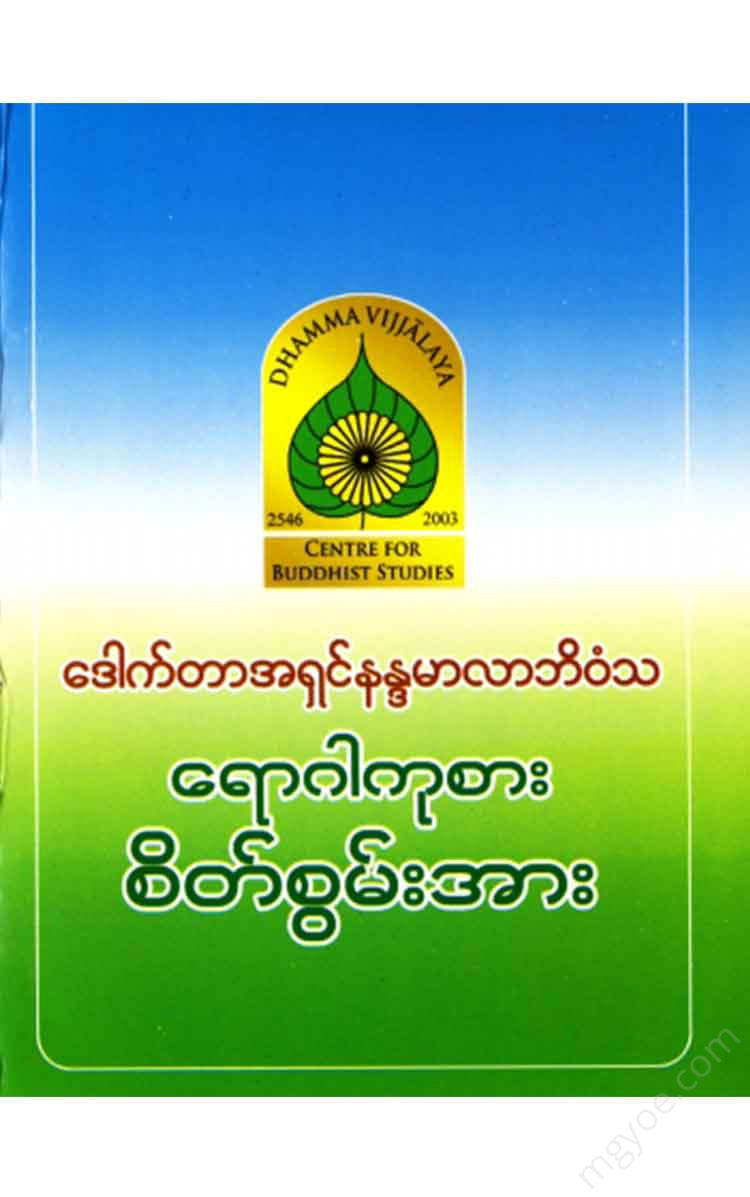Other Websites
Dr. Ashinanda Malabhavansa - The Power of the Mind to Heal Diseases
Dr. Ashinanda Malabhavansa - The Power of the Mind to Heal Diseases
Couldn't load pickup availability
Healing power
"The power of the mind that cures disease." The power of the mind can cure disease. Today's modern science also accepts this. Among the Buddha's teachings, which include the Three Compendia, the Five Discourses, and the Eighty-four Thousand Dhamma Bodies, there are records of people who calmed their minds and cured their diseases by listening to the Dhamma.
Nowadays, psychotherapy is a method of discussing and finding solutions to mental problems and treating mental illness. A doctor who treats mental illness is called a psychiatrist, and a person who discusses mental illness is called a psychotherapist.
This is not something that has come up in modern times. It has been around since the time of the Buddha. When it comes to illness, not only mental illness, but also physical illness is treated with mental power. In Buddhist countries, when someone is sick, monks are called to chant the Bodhisattva Sutta, and they do it. It is a type of psychotherapy. They believe that by chanting the Bodhisattva Sutta, the disease will be cured.
If you are suffering from a disease of enlightenment,
During the time of the Buddha, the Venerable Mahamoggallāna, the second monk who was the left-hand monk, fell ill. Although he was a monk, he was of flesh and blood, and he was sick when he fell ill. He was ill because of the effects of heat and cold and the imbalance of the four elements. When he fell ill and was sick, the Buddha himself arose and preached the Bodhisattva Sutta. Venerable Mahamoggallāna, who had heard the Bodhisattva preach, was said to have recovered from his illness without needing to take any medicine. Once it had disappeared, it had disappeared at once. This kind of illness did not arise again. The disease is always on the rise.
Modern medicines have side effects. Chemical medicines have more side effects , so medical experts are turning to the medicine that started in the beginning of the world. This is Ayurveda, and people are interested in treating with herbal medicine. As the saying goes, “Nwemyak tree is a medicine,” the search for and research on Nwemyak trees and the methods of treating them with compound medicines are now reviving and gradually becoming popular.
Because the drugs that are made with chemicals have many side effects. These drugs cure the original disease, but then cause another disease to appear. The disease that appears is treated with another drug, and that drug in turn gives birth to another disease. In this way, like the song “Ja Aye Nya Ame Rait”, it becomes “round and round, round and round, round and round”, and there is no end in sight.
So, we should not forget the Buddha's psychotherapy. Although it was not called psychotherapy during the Buddha's time, it is psychotherapy that cures a disease by listening to the Bodhisattva Sutta. By correcting the mental state, the disease is cured. In this way, the Venerable Maha Moggallana was cured of his disease.
Once, the venerable Mahakassapa was also ill in the Pippali cave. He could not go out to receive alms. “Avadhika, Dukkhita, Balangala.” Avadhika was in pain all over his body. He was very ill. Because he was so ill, the Blessed One himself went to him and asked about his condition and preached the Bojjāna Sutta. It is said that the venerable Mahakassapa once recovered from his illness without taking any medicine.
Not only that, but the Buddha himself, being of flesh and blood, sometimes fell ill. However, the physical body that the Buddha had, being "images and marks of perfection", was different from the bodies of ordinary people. However, no body is immune to disease or illness. If it is not immune to birth, it is also not immune to aging.
The 32 signs of the image of the paramita are shown in the Lakkhāna Sutta. These are called the 32 signs of the great man. Whether he is a king or a Buddha who is about to become a Buddha in his final life, these “signs of the image of the paramita” appear clearly. Why do they appear when they appear? They appear because of the good deeds that one has done. The good deeds that one has done have left their mark.
These marks may appear to ordinary people in one form or another. The full 32-fold perfection can only be found in the last life of a Buddha and a monk. But even in a monk, it is only a small thing; it is not as perfect as a Buddha. A bodhisattva is more perfect. Looking at these 32-fold perfections, the Vedas say, “This person has only two paths in his future. If he lives in human life, he will become a monk, or if he renounces worldly wealth and becomes a monk, he will become a Buddha.”
Therefore, when the Buddha was born, King Suddhodana summoned the brahmins and had them read the signs of the Buddha's body and give a prophecy. While he was doing so, seven of the eight brahmins, looking at the signs of the paramita, said that the child's future prospects were either 'good or bad.' They raised their two fingers and said, "These are the two paths." .
However, among them, a young brahmin named Kondanya, who was to become the great Venerable Kondanya, noticed the difference between the characteristics of the Buddha and the characteristics of the Buddha. The characteristics of the Buddha were more distinct. The characteristics of the Buddha were not very distinct. Seeing this difference in the distinctness and indistinctness, he raised one finger and declared, “I am absolutely certain that I will become a Buddha.” Here, the difference in knowledge arose.
Oh, this great body of the Buddha, which is reflected in such images of perfection, cannot escape aging. Nor can it escape enlightenment. Nor can it escape death. As long as the body is real, no matter whose body it is, | destruction and loss will come.
So, the Buddha himself was once ill. At that time, the Venerable Jivaka called him and did not treat him. The Buddha asked the younger brother of Sariputta, the Venerable Sunda, to recite the Sutta of Enlightenment, and he listened. As he listened to the Sutta of Enlightenment, the disease that had been clinging to the Buddha's body was completely cured. It can be said that it was cured by psychotherapy. Is that right?
Venerable Girimananda
Another is the Girimananda Sutta in the Anguttara Nikaya Dasaka Nipat. According to this sutta, once the venerable Girimananda was very ill. When he was very ill, the venerable Ananda approached the Buddha and said, “Venerable sir, Girimananda, you are very ill. Please come and pay your respects as a gesture of compassion.”
The Buddha himself often visited sick people and asked them questions and encouraged them. He did not just say, "I am the Buddha," and did not care. He went to sick people and asked them questions. He spoke to them in a reassuring manner. This kind of reassuring speech is psychotherapy. The Buddha did not just speak to them in a reassuring manner, he also did what was right and proper.
The most beautiful woman
Once upon a time, a monk named Tissa had sores all over his body and was stinking with pus. The Buddha himself went to him and washed him. That monk's title was Tissa. Because his sores were everywhere and his body was stinking with pus, he was called Putigatta. Putigatta means someone with a rotten pus body. He smelled so bad that no one wanted to come near him. The Buddha himself went and washed him and cleansed him and preached the Dhamma. It was a very good tradition.
Since Myanmar is a Buddhist country, people take the example of the Buddha and do things like chanting and chanting prayers for someone who is sick. However, some people feel even more depressed because they think that the monks chanting and chanting will make them feel better. I have heard that. If they chant and chant for themselves because they want to hear the Dhamma, that is psychotherapy.
There are diseases that can be cured and diseases that cannot be cured. No one can guarantee that they will be cured. However, even if the disease is incurable, the Dhamma can bring relief and relief from the disease.
That is why in some countries, hospitals appoint a chaplain of the patient's religion. If the patient is Buddhist, a Buddhist monk is appointed. If the patient is Christian, a Christian priest is appointed. If the patient is Muslim, a Muslim chaplain is appointed. Hospitals usually provide this program for people who are sick or who are terminally ill.
There should be many of these in Myanmar. I think there are some. There are Buddhists who do things on their own. They listen to monks on their own, and some people even go to the sarangon before they die because they can't think of themselves anymore.
In any case, you should do psychotherapy for your mental health. His mood is also important. You should give him encouragement. If you give him encouragement and his mood rises, if the disease is curable, it will go away. If it is incurable, it will not go away. This is not the same as treating diabetes. It is incurable. What can be done to cure it? Even if it is an incurable disease, if you can find happiness, it can be very beneficial.
Girimananda Sutta
Girimananda was ill and could not sit still. The Blessed One said, “Ananda, (the Blessed One did not go at that time. There must have been a reason for not going. The letter does not say why he did not go.) I will go and preach these ten points of insight to Girimananda. After hearing this, he will be well.” He taught the ten points of insight to Ananda. The ten points of insight are
(1) The concept of impermanence - the concept of impermanence, and the method of reproduction.
(2) There is no self. There is no permanent, personal thing.

